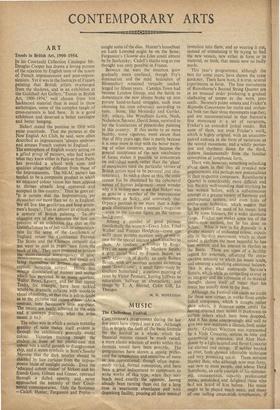CONTEMPORARY ARTS
ART Trends in British Art, 1900-1954.
TN his Courtauld Collection Catalogue Mr. Douglas Cooper has drawn a loving picture
of the rejection by English taste of the tenets
of French impressionism and post-impres- sionism. Yet it was in the footsteps of French
painting that British artists re-emerged from the shadows, and in an exhibition at the Guildhall Art Gallery, 'Trends in British
Art, 1900-1954,' well chosen from less
hackneyed material than is usual in these anthologies, some of the complex tangle of
Cross-currents is laid bare. It is a good exhibition and deserved a better catalogue and better hanging.
Sickert stated the position in 1910 with pome exactitude. That the pictures at the
New English Art Club, he said, were often
described as impressionist 'always surprises and amuses French visitors to England ...
The atmosphere of English society acting on a gifted group of painters, who had learnt what they knew either in Paris or from Paris, has provided a school with aims and qualities altogether different from those of the Impressionists. The NEAC picture has tended to be a composite product in wh.ch an educated colour vision has been appLed to themes already long approved and ttccepted in this country.' Then he goes on: 'It is certain that the Impressionists put themselves out more than we do in England. We all live like gentlemen and keep gentle- men's hours.' That is almost an epitaph on a century of British painting. To the objective eye of the historian the first im- pression of an exhibition like that at the Guildhall must be of just such an amateurish- ness (in the sense of the Gentlemen of England versus the Continental Players). The Stotts and the Clausens certainly did not want to deal in pages 'torn from the book of life.' They were prepared to jettison the sham-classical extravagance of nine- y .leademicism, hut could not brms.themseives to lettrson the specific, explicit, nameable subject. Hence that strange dissociation of manner and matter which has persisted in so many quarters. Walter Bayes,.Lavery, and for that matter Tonks, for example, have here tackled would-be. dramatic subjects with would-be visual objectivity, so that one is left in doubt 23 to the pictures real raison vlastre. (As a. contrast, note Nevinson's little war-piece. The means are tautly adjusted to the ends and it conveys precisely what the artist meant it to.) The other way in which a certain tentative gentility of taste makes itself evident is through the exhibition's generally muted colour. Victorian training taught the student in front of his plaster-cast that colour was a sinful garnish to draughtsman- ship, and it seems symbolic in Stott's Sunday Morning that the dark interior should be 4sielded by lace curtains from the impres- sionist blaze of sunlight outside. Even the 'educated colour vision' of Sickert and his friends Gore, Gilman and Ginner, operated through a dulled opacity and never approached the intensity of their Conti- nental contemporaries. Only the Scotsmen --Cadell, Hunter, Fergusson and Peploc- caught some of the élan. Hunter's houseboat on Loch Lomond might be on the Seine; Fergusson's Closerie des Lilas could almost be by Jawlensky; Cadell's blacks sing as one thought was only possible in France.
Between the wars the situation grew gradually more confused, though Fry's domination and the mild hedonism of Bloomsbury remained virtually unchal- lenged for fifteen years. Camden Town had become London Group, and the battle to domesticate the new idioms broke up into private hand-to-hand struggles, each man choosing his own adversary according to taste. Some, like Meninsky and Gcrtler, fell; others, like Wyndham- Lewis, Nash, Nicholson, Spencer, David Jones, survived to lay the feundations of present-day painting in this country. If this seems to us more healthy, more vigorous, more aware than that of fifty years ago, that is partly because it is once more in step with the better paint- ing of other countries, partly because the general acceptance of the new vocabulary of forms makes it possible to concentrate on individual worth rather than the 'place' of movements (and the particular virtues of
British artists tend to be personal and idio- syncratic). In such a show as this, the critic cannot but be chastened by the ephemeral nature of human judgcmcnt—must wonder why it is so easy now to see that Sickert was
as genu:ne a member of the impressionist movement as Sisley, and conversely that Omen's portrait is no more than a. high- grade illustration from a woman's magazine —even to the cut-out figure on the canvas background. Among a number of good pictures (incidentally the women—Gwen John, Ethel Walker and Frances Hodgkins—come qut well) space permits mention onl two for the special interest w• ptofle OF attaches to
them. At random:, llage by Roger Fry; an early still-life by Matthew Smith; a grey pastel head by Francis Bacon, an early apparition of death; an early Robert Bevan, with art nouveau accents stemming from 'Syntketistne'; a small figure-study by Graham Sutherland ; a curious painting of roses by Victor Pasmore, leaning halfway to naturalism, halfway to abstraction; and things by E. A. Hornel, Cohn Gill, La Thangue.
M. H. MIDDLETON


































 Previous page
Previous page